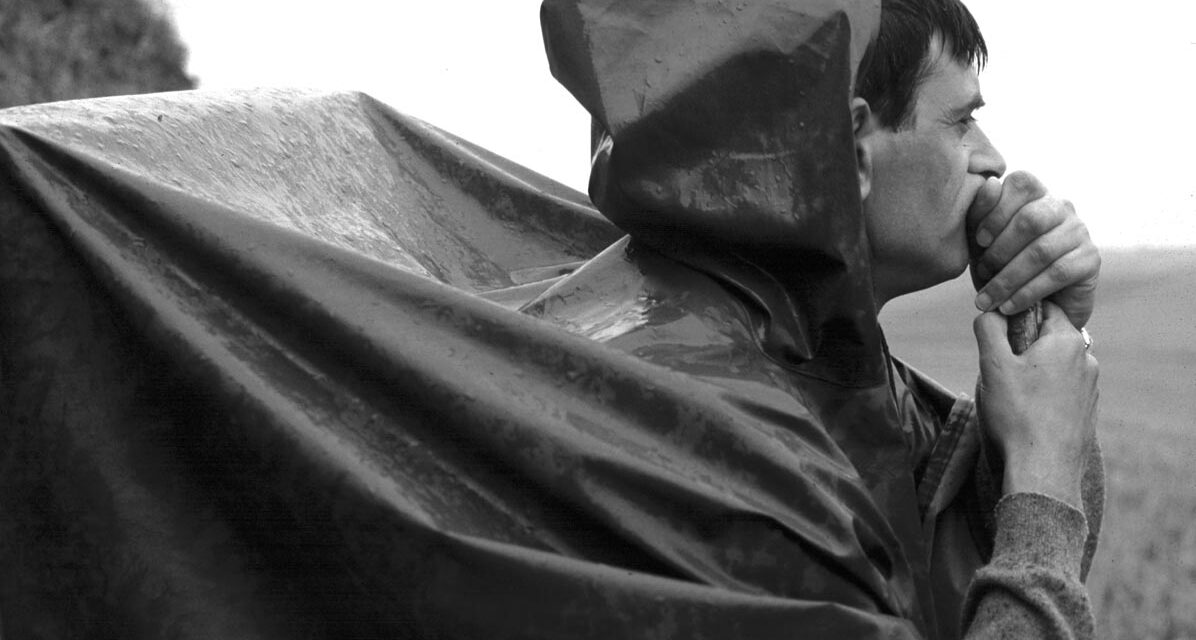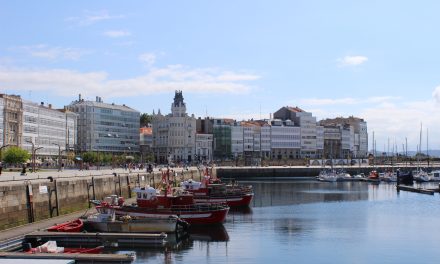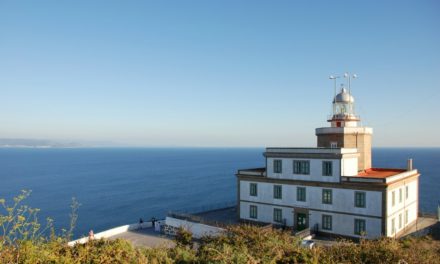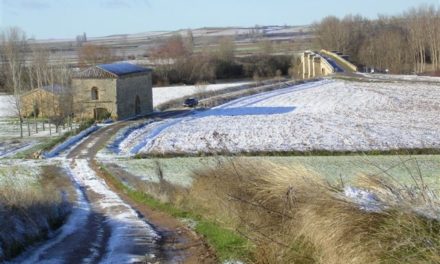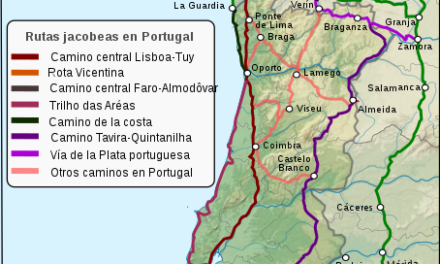Ultreia et sus eia!*
This cry or invocation was uttered by two youths who say goodbye to one another at the door of the monastery. You see right away that they come from afar. And the pilgrim accentuates the worry tic that has afflicted him since he arrived in Roncesvalles. Naturally, he knows that it was the rallying cry among pilgrims in the Middle Ages: Onwards and upwards! Not in vain has he read, or rather, devoured everything that has fallen into his hands on the Camino de Santiago in recent months.
But he still can’t believe what is irremediably happening to him at the dawn of a millennium. To begin with, it seems that such a cry has been assumed completely naturally by the groups that surround him. And then there is that kind of time tunnel in which he has immersed himself since he left the bus that transported him from Pamplona. Here, everything is Charlemagne; The Twelve Peers of France come down to discover Ibañeta, they have shown him the tomb of a gigantic king -Sancho the Strong of Navarre- and then they have introduced him, searching asleep, through unlikely corridors in the bowels of a monastery that would leave the Benedictine abbeys by Umberto Eco converted into Manhattan.
Item more, in the midst of his embarrassment, a canon has subjected him, at the end of the mass and with the church full, to the old formula of blessing with which, secularly, Roncesvalles has dismissed the pilgrims of the Apostle: “In the name of Our Lord Jesus Christ, so that you can arrive safely at the feet of Santiago and return home with joy, with the consent of God himself, who lives and reigns forever and ever.” And there he is, about to start his Camino, expectant and apprehensive before the Pilgrims’ Cross and with an almost vexatious sign lurking right under his nose: “Santiago 787 km.”
In scarlet and gold, with an immaculate backpack, “goretex” boots and a shiny pavero on his head, he knows that he has to receive the Camino at the gayola door. And somehow, Roncesvalles has made it clear. Whether he likes it or not, he is going to go through a sacred space where thousands and thousands of his predecessors have left traces and rites that he, an unrepentant urbanite, probably a university student and son of his century, will follow point by point -he has already begun- until Compostela . With a gesture he adjusts his backpack, crosses the small square and enters the forest, damp from the mist of dawn. Let’s leave him, he is already a pilgrim. And with him sails a desire that I leave embodied in the monastery book. It is, apparently, to find an old colleague. First of all, himself. Good luck and good road.
The first approach to them, to the current pilgrims, becomes evident: do the pilgrims of the 21st century have or not much to do with their colleagues from the 12th century, the undoubtedly most glorious time of the pilgrimage, or with those who followed them? through the centuries. And, in relation to this: are there, perhaps, points of contact in his cosmogony, his vision of the world? Is the current pilgrim an inveterate seeker and worshiper of relics like his predecessors? Does the current pilgrim really seek redemption? of their sins, the goal next to the distant apostolic tomb, or the goal becomes secondary, something very random, enlarging, instead, the Way itself as the almost absolute protagonist of the current pilgrimage, regardless of any goal? Is that it? true?, what ideals, if any, lead thousands of souls in our current world to flood the tow ropes as in the past?
For years eminent specialists have approached the Jacobean phenomenon trying to unravel its soul and its enigma. From there different theories were born: from Röbert Plötz’s Homo Viator, the penitential content that Mariño points out, the symbolic function of the itinerary that Turner indicates or even the famous secular god that Ortega y Gasset pointed out precisely in times when “that enormous mountain of god seemed to vanish on the horizon”.
There is no doubt about it, and it is evident for anyone who approaches the Way, that the pilgrim seems to live in a liminal period, submerged in a bubble and oblivious to almost everything, during a journey where rites and symbols take on an important fundamental. Rites, legends and symbols of the past that they have made their own (such as the pilgrim’s blessing in Roncesvalles, putting their hands on the Jesse tree before the Pórtico de la Gloria was kidnapped, or throwing their stone at the Cruz de Ferro) and even rites of the present, born with the current renaissance of pilgrimages, such as the intense line of monjois created at various points along the Way, the ceremonies of purification of clothes by fire and the ritual baths in the Finisterre, and even attending the queimadas evocative of the good Jesús Jato in Villafranca. Obtaining the Compostela itself has become yet another rite for many pilgrims, whether or not they do the Camino for strict religious reasons. The flexible character of all the ritual that presides over the Way allows not only that old elements be completed with new content, but also that other innovative elements can be included without any problem, while the symbolic function of the itinerary itself is very powerfully highlighted. The pilgrim conceives it as a sacred space, bequeathed by history. An important space in itself also as a ritual space.
It is for all these reasons that some anthropologists have studied the pilgrimage as a symptomatic phenomenon of a society that perceives its status as critical, at the dawn of a millennium full of uncertainties, perhaps appealing to resources from an excessively mythologized past to cover up the shortcomings. of the current time. All this leads to a present as a representation of a “negative” moment of very important values such as solidarity, spirituality, nature or the very hospitality so experienced on the Camino de Santiago.
That is why society itself generates instrumental and symbolic resources to compensate for this lack of values in periods of crisis. And it is also for this reason that the Camino is an ideal space and a perfect material support for a series of ideas, values and representations of reality that are currently clearly perceived as bankrupt and which seem to require reaffirmation and revitalization. In turn, the man of the present, overwhelmed and alienated by the times in which he has had to live, strips himself of almost everything and introduces himself with light luggage into a sacred space that equals everyone under the backpacks.
Pilgrimage thus becomes an escape route, a trip to Ithaca passing through Sparta, where each person can question his own life, confused and equated with other similar people who live similar concerns accompanied by their own shadow, sometimes one’s only company from sunrise to sunset. Everything invites one to plunge into a state of reflection that is impossible in the harsh conditions of life and work in big cities, in a world dominated by haste and stress, to the point that for many the pilgrimage is a true catharsis. The Camino provides something very difficult to achieve in our days- distancing. Meaning distancing from the family, from one’s own responsibilities, from one’s own daily life and from the society to which one belongs.
His coordinates are no longer, of course, the same as his predecessors, neither is his world and in no way does the current pilgrim compulsively pursue any relic. But they unite him with his predecessors, in the restlessness, the search and the spirit of adventure. And the full identification, and without conditions, in rites, legends, experiences and beliefs of the past that they perfectly agree to assume as soon as they immerse themselves in the catharsis of that sacred space.
That introspection, that catharsis, demands a solitary and free Path, the Path is freedom or it is nothing, walking in the company of others requires concessions that are far, very far, from that distancing from any type of social convention, from that “undress”: “to the left or to the right?, shall we rest here or commit suicide?, a little beer and we’ll see, look what a little bar!, shall we continue to Foncebadón or anchor in Rabanal?” Dozens and dozens of daily decisions and resignations that involve walking in a group. And dozens and dozens of unthinkable concessions in someone who has made freedom his flag in the last adventure that remains to be lived in Europe. The Camino is lived as an intense individual experience, the result of a commitment that is also strictly individual.
—-
Walk on your shadow. At dawn he chases her. She gets dark and is left behind. Sometimes the heat throws him, in the Castilian night of the Gothic fields, in the arms of Aldebaran, Orion, Sirius, the Pleiades. Milky Way. “Pietatis causa, devotionis affects, votis causa.” It seems impossible but yes, it is the same quail that accompanies her solitude from Hontanas, through Castrojeriz and Mostelares to the gates of Frómista. “Pietatis causa” In Camino the past is lived as present and this as future. medieval revival? Experts call it anamnesis. His footsteps follow thousands of others. He is soon noticed. The mud they left on the sidewalks brought this mud from the depths of the centuries.
I do not sing my song but who goes with me? Indubitable. The pilgrim advances in a bubble fearful of losing the charm. And he does it in solitude, already at nightfall in the shelters, on the edge of the Way, mutual acknowledgments will arrive. After having abandoned their usual environment, adopting a costume that includes a staff, “ad hoc” hat and venera as visible symbols of their current state and condition, move “per agere” and travel in freedom and in strange lands for thirty or forty kilometers of loneliness, quail, dust and fatigue, under the chapeu walks an individual anxious to communicate with other fellow soldiers who share the same codes. But these keys must be allowed to flow in the solitude of the Camino, introspection will do the rest, but that will never be done in a group, it requires, as we have seen, solitude, distance, freedom. From there arises solidarity, not forced at all, but spontaneous and unconditional, between the Tuscan lawyer, the gardener from Leuven and the teacher from Alicante. His trail is easy to follow in the pilgrim books that are in the hostels. They appear full of joyful reunions, notices to sailors and heartbreaking farewells between people who have seen each other, if possible, three days, perhaps for many the fullest of their existence. Something that would never allow belonging to “a group”, wrapped in itself, limited to its components, opposed (even by definition) to opening up in freedom.
—-
A trailer in Mellide has blown his ass (and almost his brains out). Undressed, it continues between infinite eucalyptus trees with the omnipresent rain. In the chapel of San Roque, in Labacolla, he pauses briefly. He has passed test after test. The last one was particularly painful, he has had to endure the beating of an esoteric, a follower of Pablito Coelho, until he misled him in Castaneda. He recovers – “as long as you yearn to get there, you will be a slave to the Camino”, a wise man, Jesús Jato, had told him before the church of Santiago de Villafranca – and soon arrives at the small hermitage of San Marcos, the Mons Gaudii where Laffi broke down in sobs, where everyone burst with joy at the sight, in the distance, of the towers of the cathedral.Now everything is joyous descent.
Compostela, Compositum, Campus Stellae, Arcis Marmoricis, Jakobsland. The pilgrim enters the Rúa de San Pedro and, subtly, he is enveloped by the charm of a unique, unrepeatable city, “the happiest and most exalted of the cities of Spain”.
The basilica is packed, a convention of veterinarians from nowhere and an entire congress of poncios in gastronomy “do Camiño” nod, beatifically and in unison, to the rhythm of a botafumeiro that takes off from the stone cross. A guy cradled against a column dispatches orders on a mobile phone. As if on a cloud, he makes his way, biting by the staff. He goes up the short stairs. There he is he. And there he is. No one can take away the infinite, warm, excited hug.
Franco’s figones see him pass. He has passed the procedure and in his backpack he carries his Compostela. He is invaded by a strange, new feeling: Is it all over? And now that? On a bench in La Herradura, with the towers of the cathedral before him, with all its beauty now bathed in a straw-colored sun, he feels in his shirt pocket the wrinkled cigarette he has kept since Roncesvalles. He resisted, the fucker, and he resisted, is he a new man? He is a different man. Distracted, he takes a railway ticket out of his backpack. He falls asleep and ponders: Finisterrae? Census? Life? He gets up and walks. Smile, smile widely. He has advanced alone and without concessions through that incredible legacy of history that is the Camino de Santiago and it is very likely that he has been able to pick up bits of what was left of himself. Precisely because he has walked in his own company, in endless circumlocution following his long shadow projected to the West in the mornings. He already belongs to the Camino and knows that this experience can be repeated whenever a single pilgrim hangs his soul from his staff and advances, one step, and another, and another, towards the distant tomb of the West.
Ultreia? Of course: ¡Ultreia e sus eia! And… ¡Deus adjuvanos!
* Jose Antonio de la Riera is a pilgrim, writer, researcher, founding member of the International Fraternity of the Camino de Santiago (FICS) and the Vía Mariana Association.
PHOTO: Manuel G. Vicente

